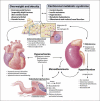The Role of Overweight and Obesity in the Cardiorenal Syndrome
- PMID: 22258461
- PMCID: PMC3101516
- DOI: 10.1159/000322822
The Role of Overweight and Obesity in the Cardiorenal Syndrome
Abstract
The presence of a group of interactive maladaptive factors including hypertension, insulin resistance, metabolic dyslipidemia, obesity, microalbuminuria, and/or reduced renal function constitute the cardiorenal metabolic syndrome (CRS). Overweight, obesity, and chronic kidney disease (CKD) have grown to pandemic proportions in industrialized countries during the past decade. The fact that these interactive factors promote heart and renal disease has been documented in large population-based studies. Obesity seems to be the driving force behind the development of heart disease and CKD and therefore the CRS. The relationship between overweight/obesity and kidney disease begins in early childhood and appears to be related to overconsumption of high-fructose corn syrup and insufficient physical activity. Today, 13 million children are obese, and over 70% of these children are likely to become obese adults. Indeed, approximately 30% of male and 34% of female adults in the United States are obese. This lifestyle-related epidemic will be a major societal medical and economic problem that will accentuate the current epidemic of CKD in the United States and other industrialized and emerging industrialized countries. In this article, we will review the potential mechanisms by which obesity and other metabolic abnormalities interact to promote heart and progressive kidney disease.
Keywords: Adiposity; Cardiorenal metabolic syndrome; Chronic kidney disease; Heart failure; Metabolic dyslipidemia; Obesity.
© 2011 S. Karger AG, Basel.
Figures

References
-
- Ogden CL, Carroll MD, Curtin LR, McDowell MA, Tabak CJ, Flegal KM. Prevalence of overweight and obesity in the United States, 1999–2004. JAMA. 2006;295:1549–1555. - PubMed
-
- McGee DL, Diverse Populations Collaboration Body mass index and mortality: a meta-analysis based on person-level data from twenty-six observational studies. Ann Epidemiol. 2005;15:87–97. - PubMed
-
- Ghandehari H, Le V, Kamal-Bahl S, Bassin SL, Wong ND. Abdominal obesity and the spectrum of global cardiometabolic risks in US adults. Int J Obes (Lond) 2009;33:239–248. - PubMed
-
- Sowers JR. Obesity as a cardiovascular risk factor. Am J Med. 2003;115(suppl 8A):37S–41S. - PubMed
-
- Liese AD, Hense HW, Döring A, Stieber J, Keil V. Microalbuminuria, central adiposity and hypertension in the non-diabetic urban population of the MONICA Augsburg survey 1994/95. J Hum Hypertens. 2001;15:799–804. - PubMed
Grants and funding
LinkOut - more resources
Full Text Sources
Miscellaneous
